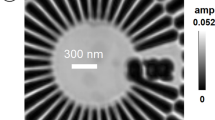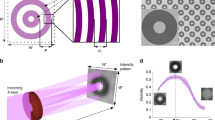Abstract
Near-edge X-ray absorption spectroscopy (NEXAFS)1 is an essential analytical tool in material science. Combining NEXAFS with scanning transmission X-ray microscopy (STXM) adds spatial resolution and the possibility to study individual nanostructures2,3. Here, we describe a full-field transmission X-ray microscope (TXM) that generates high-resolution, large-area NEXAFS data with a collection rate two orders of magnitude faster than is possible with STXM. The TXM optical design combines a spectral resolution of E/ΔE = 1 × 104 with a spatial resolution of 25 nm in a field of view of 15–20 µm and a data acquisition time of ∼1 s. As an example, we present image stacks and polarization-dependent NEXAFS spectra from individual anisotropic sodium and protonated titanate nanoribbons. Our NEXAFS-TXM technique has the advantage that one image stack visualizes a large number of nanostructures and therefore already contains statistical information. This new high-resolution NEXAFS-TXM technique opens the way to advanced nanoscale science studies.
This is a preview of subscription content, access via your institution
Access options
Subscribe to this journal
Receive 12 print issues and online access
$209.00 per year
only $17.42 per issue
Buy this article
- Purchase on Springer Link
- Instant access to full article PDF
Prices may be subject to local taxes which are calculated during checkout




Similar content being viewed by others
References
Ade, H. & Hitchcock, A. P. NEXAFS microscopy and resonant scattering: composition and orientation probed in real and reciprocal space. Polymer 49, 643–675 (2008).
Najafi, E. et al. Polarization dependence of the C 1s X-ray absorption spectra of individual multi-walled carbon nanotubes. Small 4, 2279–2285 (2008).
Felten, A. et al. Individual multiwall carbon nanotubes spectroscopy by scanning transmission X-ray microscopy. Nano Lett. 7, 2435–2440 (2007).
Sasaki, T. et al. Performance of low-voltage STEM/TEM with delta corrector and cold field emission gun. J. Electron. Microsc. 59, S7–S13 (2010).
Suenaga, K. & Koshino, M. Atom-by-atom spectroscopy at graphene edge. Nature 468, 1088–1090 (2010).
Krivanek, O. L. et al. High-energy-resolution monochromator for aberration-corrected scanning transmission electron microscopy/electron energy-loss spectroscopy. Phil. Trans. R. Soc. A 367, 3683–3697 (2009).
Hitchcock, A. P., Dynes, J. J., Johansson, G., Wang, J. & Botton, G. Comparison of NEXAFS microscopy and TEM-EELS for studies of soft matter. Micron 39, 311–319 (2008).
Stohr, J., Padmore, H. A., Anders, S., Stammler, T. & Scheinfein, M. R. Principles of X-ray magnetic dichroism spectromicroscopy. Surf. Rev. Lett. 5, 1297–1308 (1998).
Smith, A. P. & Ade, H. Quantitative orientational analysis of a polymeric material (Kevlar® fibers) with X-ray microspectroscopy. Appl. Phys. Lett. 69, 3833–3835 (1996).
Locatelli, A. & Bauer, E. Recent advances in chemical and magnetic imaging of surfaces and interfaces by XPEEM. J. Phys. Condens. Matter 20, 093002 (2008).
Jacobsen, C., Wirick, S., Flynn, G. & Zimba, C. Soft X-ray spectroscopy from image sequences with sub-100 nm spatial resolution. J. Microsc. 197, 173–184 (2000).
Krivanek, O. L. et al. Gentle STEM: ADF imaging and EELS at low primary energies. Ultramicroscopy 110, 935–945 (2010).
Suenaga, K. et al. Visualizing and identifying single atoms using electron energy-loss spectroscopy with low accelerating voltage. Nature Chem. 1, 415–418 (2009).
Schneider, G. Cryo X-ray microscopy with high spatial resolution in amplitude and phase contrast. Ultramicroscopy 75, 85–104 (1998).
Schneider, G. et al. Three-dimensional cellular ultrastructure resolved by X-ray microscopy. Nature Methods 7, 985–987 (2010).
Umek, P., Korosec, R. C., Jancar, B., Dominko, R. & Arcon, D. The influence of the reaction temperature on the morphology of sodium titanate 1D nanostructures and their thermal stability. J. Nanosci. Nanotechnol. 7, 3502–3508 (2007).
Kruger, P. Multichannel multiple scattering calculation of L2,3-edge spectra of TiO2 and SrTiO3: importance of multiplet coupling and band structure. Phys. Rev. B 81, 125121 (2010).
Jamnik, J. et al. Stabilizers of particle size and morphology: a road towards high-rate performance insertion materials. Adv. Mater. 21, 2715–2719 (2009).
Han, C. H. et al. Synthesis of Pd or Pt/titanate nanotube and its application to catalytic type hydrogen gas sensor. Sens. Actuat. B 128, 320–325 (2007).
Baiju, K. V. et al. Correlating photoluminescence and photocatalytic activity of mixed-phase nanocrystalline titania. Catal. Lett. 130, 130–136 (2009).
Qu, J., Gao, X. P., Li, G. R., Jiang, Q. W. & Yan, T. Y. Structure transformation and photoelectrochemical properties of TiO2 nanomaterials calcined from titanate nanotubes. J. Phys. Chem. C 113, 3359–3363 (2009).
Diebold, U. The surface science of titanium dioxide. Surf. Sci. Rep. 48, 53–229 (2003).
Brydson, R. et al. Electron energy-loss spectroscopy (EELS) and the electronic-structure of titanium-dioxide. Solid State Commun. 64, 609–612 (1987).
Degroot, F. M. F., Fuggle, J. C., Thole, B. T. & Sawatzky, G. A. L2,3 X-ray-absorption edges of D0 compounds—K+, Ca2+, Sc3+ and Ti4+ in Oh (octahedral) symmetry. Phys. Rev. B 41, 928–937 (1990).
Crocombette, J. P. & Jollet, F. Ti 2p X-ray-absorption in titanium dioxides (TiO2)—the influence of the cation site environment. J. Phys. Condens. Matter 6, 10811–10821 (1994).
Andrusenko, I. et al. Structure analysis of titanate nanorods by automated electron diffraction tomography. Acta Crystallogr. B 67, 218–225 (2011).
Umek, P. et al. Coordination of intercalated Cu2+ sites in copper doped sodium titanate nanotubes and nanoribbons. J. Phys. Chem. C 112, 15311–15319 (2008).
Rehbein, S., Heim, S., Guttmann, P., Werner, S. & Schneider, G. Ultrahigh-resolution soft-X-ray microscopy with zone plates in high orders of diffraction. Phys. Rev. Lett. 103, 110801 (2009).
Humar, M. et al. Mechanical properties of titania-derived nanoribbons. Nanotechnology 17, 3869–3872 (2006).
Papa, A. L., Millot, N., Saviot, L., Chassagnon, R. & Heintz, O. Effect of reaction parameters on composition and morphology of titanate nanomaterials. J. Phys. Chem. C 113, 12682–12689 (2009).
Acknowledgements
The authors thank S. Heim and R. Follath for their support during the development of the TXM and beamline. This work was funded in part by the Human Frontier Science Program (research grant RGP0053/2005-C), the German Federal Ministry of Education and Research (contract 05KS4BY1/7), the Helmholtz-Zentrum Berlin für Materialien und Energie GmbH, the Slovenian Research Agency (J2-9217), the COST Action MP0901, and the European Commission (contracts RII3-CT 2004-506008 (IASFS) and ERC 246791 (COUNTATOMS and ESMI)).
Author information
Authors and Affiliations
Contributions
P.G. contributed to the design and construction of the microscope and collected all NEXAFS data sets. C.B. prepared all of the specimens, helped collect the X-ray data and performed the analysis of the NEXAFS data. S.R. designed and constructed the zone plate objectives and assisted with microscope construction. P.U. synthesized the nanostructures and, together with X.K., performed TEM and SEM analysis, G.V.T. and C.P.E., together with C.B., analysed the NEXAFS and electron microscopy data. G.S. had the idea for the new TXM, directed the X-ray microscopy project and designed and built the microscope with his colleagues. All authors read and contributed to the Article.
Corresponding authors
Ethics declarations
Competing interests
The authors declare no competing financial interests.
Supplementary information
Supplementary information
Supplementary information (PDF 509 kb)
Rights and permissions
About this article
Cite this article
Guttmann, P., Bittencourt, C., Rehbein, S. et al. Nanoscale spectroscopy with polarized X-rays by NEXAFS-TXM. Nature Photon 6, 25–29 (2012). https://doi.org/10.1038/nphoton.2011.268
Received:
Accepted:
Published:
Issue Date:
DOI: https://doi.org/10.1038/nphoton.2011.268
This article is cited by
-
Recent Progress in Interfacial Dipole Engineering for Perovskite Solar Cells
Nano-Micro Letters (2023)
-
Phase transformation mechanism in lithium manganese nickel oxide revealed by single-crystal hard X-ray microscopy
Nature Communications (2017)
-
Nanoscale characterization of local structures and defects in photonic crystals using synchrotron-based transmission soft X-ray microscopy
Scientific Reports (2016)
-
Spatially resolved TiOx phases in switched RRAM devices using soft X-ray spectromicroscopy
Scientific Reports (2016)
-
Spectromicroscopy of C60 and azafullerene C59N: Identifying surface adsorbed water
Scientific Reports (2016)



